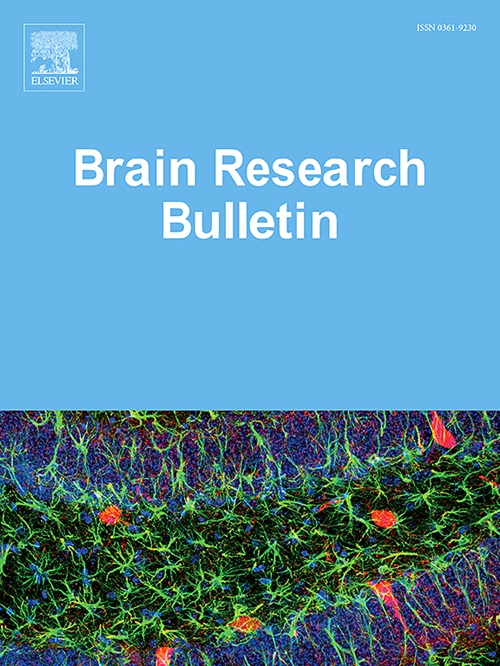肠道微生物群组成的改变对心血管疾病患者神经血管耦合和认知功能障碍的影响。
IF 3.5
3区 医学
Q2 NEUROSCIENCES
引用次数: 0
摘要
导言:越来越多的研究探讨了肠道微生物群在脑小血管疾病(CSVD)中的关键作用。本研究旨在调查 CSVD 患者肠道微生物群结构的改变,探讨不同分类水平与神经血管耦合指数和认知功能之间的相关性,并阐明 CSVD 患者轻度认知障碍(MCI)的影像学和生物标志物:我们招募了 104 名 CSVD 患者和 40 名健康对照组(HC)。根据认知测试评分,CSVD 患者被分为认知正常组(CSVD-NCI,61 人)和轻度认知障碍组(CSVD-MCI,43 人)。对所有参与者进行磁共振成像(MRI)扫描、肠道微生物群分析以及临床和神经心理学评估。根据动脉自旋标记(ASL)和血氧水平依赖性(BOLD)成像数据,计算脑血流(CBF)和神经活动指数。计算CBF/mReHo、CBF/mfALFF、CBF/mALFF和CBF/mDC的耦合指数,以评估CSVD患者的全脑神经血管耦合变化:结果:物种注释显示,HC组、CSVD-NCI组和CSVD-MCI组在门和属的组成上存在差异。此外,使用 Kruskal-Wallis 检验法进行的差异分析表明,所有三组中都存在特定的优势微生物群落。CSVD 患者体内某些优势微生物群落的相对丰度与神经血管耦合和认知功能存在相关性。事实证明,嗜酸乳杆菌属和CBF/mDC的联合评估能有效区分CSVD-NCI和CSVD-MCI,为诊断CSVD中的MCI提供了一种新的无创方法。本文章由计算机程序翻译,如有差异,请以英文原文为准。
The influence of alterations in the composition of intestinal microbiota on neurovascular coupling and cognitive dysfunction in individuals afflicted with CSVD
Introduction
An expanding body of research has explored the crucial role of gut microbiota in cerebral small vessel disease (CSVD). The objective of this study is to investigate alterations in the gut microbiota structure among CSVD patients, to explore the correlation between differential taxonomic levels and the neurovascular coupling index as well as cognitive function and to elucidate the imaging and biomarkers of mild cognitive impairment (MCI) in CSVD.
Methods
We enrolled 104 patients with CSVD and 40 healthy controls (HC). Based on cognitive test scores, CSVD patients were categorized into a cognitively normal group (CSVD-NCI, n=61) and a mild cognitive impairment group (CSVD-MCI, n=43). Performing magnetic resonance imaging (MRI) scans, gut microbiota analysis, as well as clinical and neuropsychological assessments for all participants. Based on arterial spin labeling (ASL) and blood oxygen level-dependent (BOLD) imaging data, cerebral blood flow (CBF) and neural activity indices are computed. The coupling indices of CBF/mReHo, CBF/mfALFF, CBF/mALFF, and CBF/mDC are calculated to assess the whole-brain neurovascular coupling changes in patients with CSVD.
Results
Species annotation revealed differences in the composition at the phylum and genus levels among the HC, CSVD-NCI, and CSVD-MCI groups. Additionally, differential analysis using the Kruskal-Wallis test demonstrated specific dominant microbial communities in all three groups. The relative abundance of certain dominant microbial communities in CSVD patients exhibited correlations with neurovascular coupling and cognitive function. The combined assessment of Bacteroides genus and CBF/mDC proved effective in distinguishing between CSVD-NCI and CSVD-MCI, providing a novel non-invasive approach for the diagnosis of MCI in CSVD.
求助全文
通过发布文献求助,成功后即可免费获取论文全文。
去求助
来源期刊

Brain Research Bulletin
医学-神经科学
CiteScore
6.90
自引率
2.60%
发文量
253
审稿时长
67 days
期刊介绍:
The Brain Research Bulletin (BRB) aims to publish novel work that advances our knowledge of molecular and cellular mechanisms that underlie neural network properties associated with behavior, cognition and other brain functions during neurodevelopment and in the adult. Although clinical research is out of the Journal''s scope, the BRB also aims to publish translation research that provides insight into biological mechanisms and processes associated with neurodegeneration mechanisms, neurological diseases and neuropsychiatric disorders. The Journal is especially interested in research using novel methodologies, such as optogenetics, multielectrode array recordings and life imaging in wild-type and genetically-modified animal models, with the goal to advance our understanding of how neurons, glia and networks function in vivo.
 求助内容:
求助内容: 应助结果提醒方式:
应助结果提醒方式:


